Yellow shrimp | Neocaridina davidi var. "Yellow" | Care & info
Neocaridina davidi var. "Yellow", commonly known as yellow shrimp, is one of the most popular dwarf shrimp varieties in the aquarium hobby. As the name suggests, this shrimp is selectively bred for its super bright, eye-catching yellow color. It is unfussy about water values and breeds easily, which makes it a great option for anyone just starting out.
Keep reading for everything you need to know about yellow shrimp care and keeping this dwarf shrimp in your home aquarium!
| Scientific name | Neocaridina davidi var. "Yellow", formerly Neocaridina heteropoda var. Yellow |
| Common names | Yellow shrimp, neon yellow shrimp, yellow cherry shrimp |
| Difficulty level | Easy |
| Origin | Taiwan |
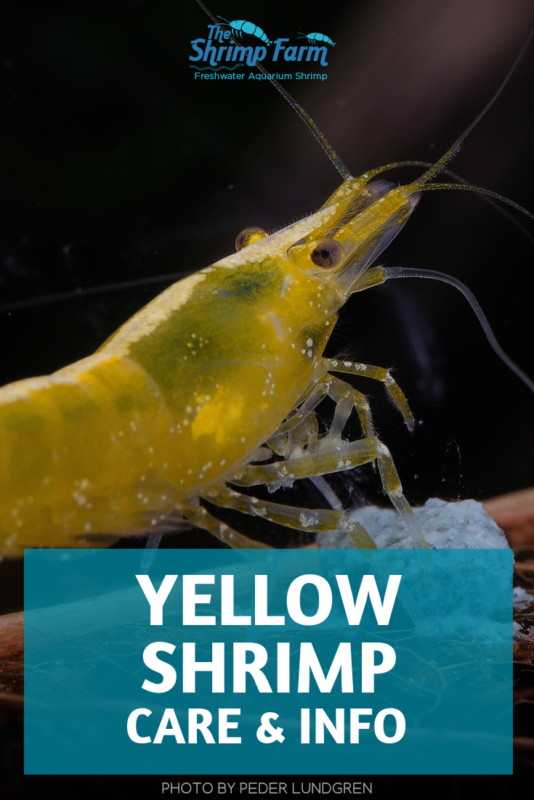
Table of Contents
Setting up a yellow shrimp aquarium
Requirements
Yellow shrimp are one of the easier shrimp species to keep in the aquarium and don't have many specific requirements. No special soil types or fancy equipment needed! Like all dwarf shrimp, these can be kept in aquariums of at least 5 gallons, although for beginners and anyone concerned about water quality it's always a good idea to go for a slightly larger setup.
The aquarium should always be filtered and fully cycled before any livestock is introduced. Any filter should work well, but keep in mind that baby shrimp are very small. Always use a prefilter sponge (or, alternatively, a sponge filter) to prevent them from disappearing into the intake. A heater isn't necessary, as these shrimp can tolerate a very wide range of temperatures as long as things are stable.
Shrimp are prey animals that don't feel safe in open spaces, so be sure to provide your Neocaridina davidi var. "Yellow" colony with plenty of hiding places. Don't worry about not ever seeing them: the safer the shrimp, feel the more time they spend out in the open. Fine-leaved plants, shrimp tubes, rocks and driftwood all provide shelter and should be appreciated. You can also add leaf litter, which imitates their natural habitat and acts as an extra food source.
Water quality
Like their popular cherry shrimp cousins, yellows are very adaptive and can survive in a wide range of water values and temperatures. As long as the water is conditioned, ammonia and nitrite are always at zero and nitrites aren't too high, your tap water should usually be fine.
Be sure to do regular water tests using a liquid test kit to make sure everything is still in order. Perform regular water changes.
pH: 6.2-8
Temperature: 65-85 °F
GH: 4-8
KH: 3-15
Total Dissolved Solids: 150-250
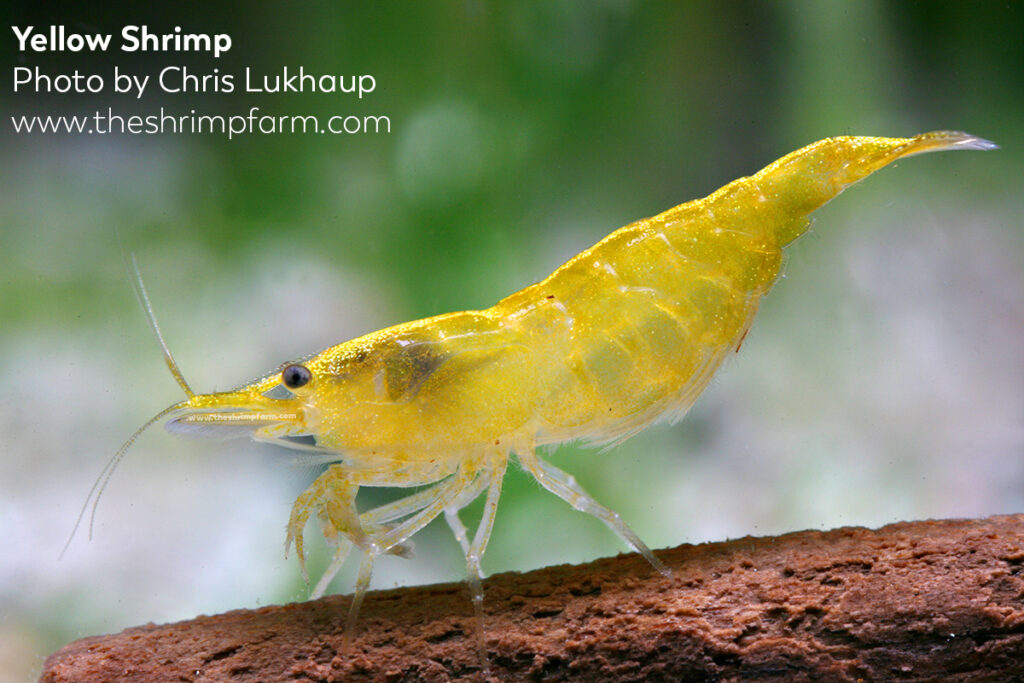
Tankmates
Because these shrimp breed so quickly, there are a little more options than usual when it comes to tankmates. Even if a few young are occasionally eaten, new ones should appear quickly enough to sustain the population.
If breeding isn't your primary goal, you can therefore keep these shrimp in peaceful community aquariums. Other shrimp/invertebrates and small schooling fish should pose little threat. You can even consider slightly more "aggressive" fish, like livebearers, as long as there are plenty of hiding places for young shrimp.
If your main goal is breeding, it's a better idea to stick to just shrimp and maybe a few peaceful aquarium snails. Be sure not to mix multiple Neocaridina shrimp species unless you know what you're doing; the color combinations look great at first, but interbreeding will result in offspring with brown wild-type coloration. This means, for example, that you shouldn't combine yellow shrimp with cherry shrimp.
Yellow shrimp diet
Yellow shrimp are omnivores that thrive on a varied diet. They will love picking algae and aufwuchs off any surface they can find, but unless your tank is very algae-ridden, they do need regular supplemental feedings. Use a high-quality shrimp food as a staple and add variety with algae tablets, frozen foods (mosquito larvae, bloodworms), fresh blanched veggies and sinking fish foods.
Be sure to remove any uneaten food after a few hours, as it can quickly start rotting and affecting water quality. Consider using a feeding dish to prevent the food from ending up all over the aquarium.
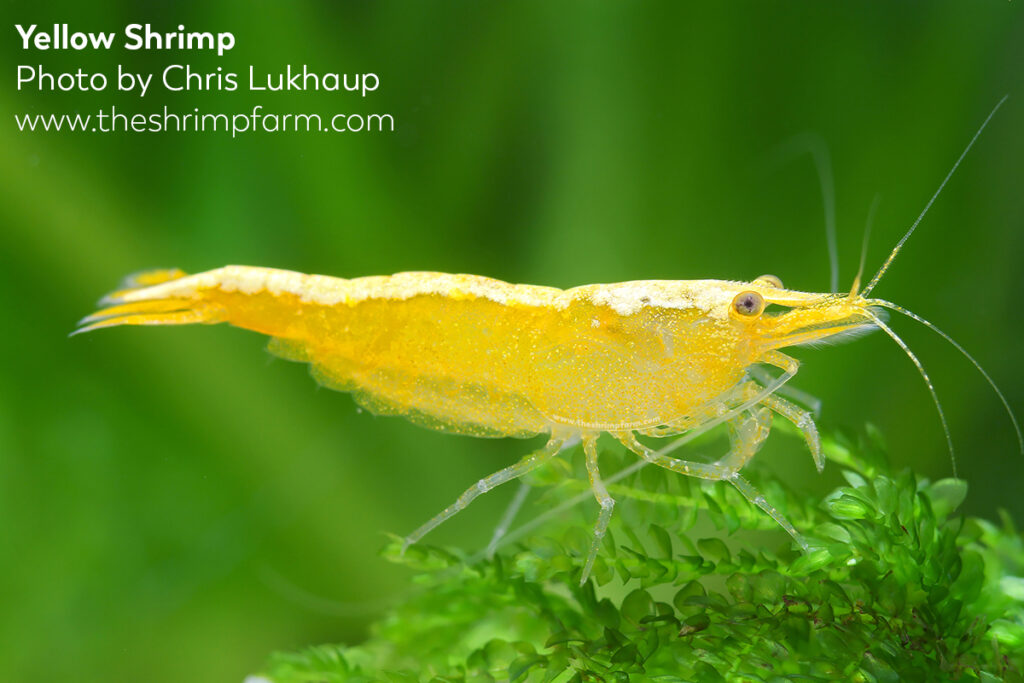
Yellow shrimp behavior
It's important to know what normal behavior looks like in your shrimp, especially if you are new to the hobby. This way, you can quickly spot any issues. A few of the basics to keep in mind are:
- Yellow shrimp spend the majority of their day foraging. You will see their tiny claws picking tasty morself off pretty much any surface in the aquarium. They rarely sit still.
- The response to food is strong, with shrimp flocking in large numbers to anything edible you toss into the tank.
- Breeding time is marked by increased swimming behavior, with the shrimp zooming all over the aquarium.
- Molting time is marked by a decrease in activity. A freshly molted shrimp might not show itself for a few days until its new carapace has hardened enough for it to feel safe.
Breeding yellow shrimp
Breeding is definitely the most fun part of keeping yellow shrimp, as these Neocaridinas are among the easiest shrimp to breed. They're basically set and forget, which makes them a great choice for beginners or anyone looking for a breeding project that's not too effortful.
To breed your Neocaridina davidi var. "Yellow", introduce both males and females into the aquarium. Keep the water quality high and provide plenty of food. Healthy females should soon start carrying little eggs between their back legs (swimmerets), from which tiny copies of the parents hatch after around 30 days.
Identifying male and female yellow shrimp
Most aquarists start with a yellow shrimp starter colony of 5-10 shrimp, which means there's almost always a very good chance you've got both males and females. If you're not sure, though, no worries either: these shrimp are sexually dimorphic, which means you can tell the difference between males and females visually.
A female Neocaridina shrimp will be larger and more intensely colored. The males are more translucent and also stay significantly smaller. You can find more information in the guide to sexing Neocaridina dwarf shrimp.
Yellow shrimp grading
If you're breeding your shrimp to sell, keep in mind that some are higher "quality" than others. The more intense a shrimp's coloration, the higher the grade it falls into. Higher grade shrimp with opaque, bright colors will fetch more money than translucent ones. This is just a color thing, though; yellower shrimp are not healthier or inherently better.
Want to know more? Have a look at our full yellow shrimp grading guide!
Frequently asked questions
Yes, these are both Neocaridina davidi varieties and they can interbreed. If you're trying to breed a pure yellow line, it's therefore not a good idea to keep them together.
Buying yellow shrimp
With the growing popularity of the shrimp hobby including Neocaridina varieties like this one, it shouldn't be too hard to find yellows. Your local aquarium store might sell them or you can try finding another hobbyist willing to sell or trade a few.
If you don't want to leave the comfort of your home, you can buy high quality yellow shrimp at The Shrimp Farm here and have them shipped right to your doorstep!



 Shrimp
Shrimp Fish
Fish Crab &
Crab & Plants
Plants Foods
Foods Snails
Snails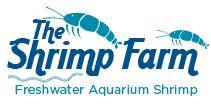
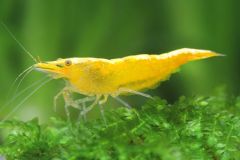
3 Comments